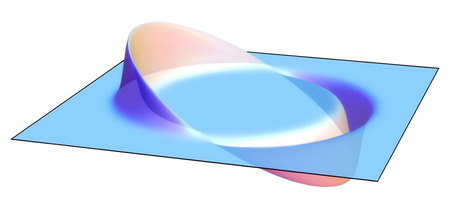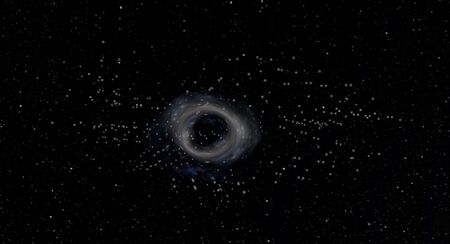Faster-Than-Light Travel (A1-0)
Faster Than Light Travel, also known as Superluminal Travel and commonly abbreviated to FTL Travel, refers to any form of travel that exceeds the universal speed of light limit. In the millennia, many different species and civilizations have invented or discovered many different methods to allow for superluminal speeds. While each of these methods is different from one another, they can be divided into four broad categories, each with it's own common limitations:
Realspace FTL

Warp Field Drive
A Warp Field Drive, also known as an Alcubierre Warp Drive, uses exotic matter, dark energy manipulation, gravitometric manipulation or energy concentration to expand spacetime behind a ship, and contract it in front of it. This allows for the creation of a bubble-shaped field of isolated spacetime, known as a Warp Bubble or as a Displacement Field, that remains unaltered compared to the surrounding universe. The bubble can then move at speeds far exceeding the normal universal lightspeed limit, without breaking the laws of causality and creating closed time-like curves. The vessel inside the Warp Bubble stays effectively still, and does not suffer from time dilations or contraptions.
The generation of a Warp Bubble requires tremendous amounts of energy, that can be created from antimatter-matter total energy conversions, or by self-sustaining monopole enhanced fusion. To generate a stable enough Bubble, ships can either concentrate energy in specially designed external Nacelles, or can disperse energy more evenly throughout the ship.
Known Users:
Interdimensional FTL
AlterSpace Drive
HyperSpace Drive
JumpSpace Drive
A JumpSpace Drive uses artificially and on occasion naturally created JumpCrystals, these triangular crystals are created by classified means. The Process of reaching JumpSpace requires a Jump Portal, which can be created by using a Jump Portal Beam(NOTE: Only One Ship is ever needed to open a portal, multiple vessels equipped with JumpSpace Drives can use the same portal). These Portals have a turquoise hue and often swirl while open, before rapidly collapsing after the Beam Ship jumps. All Vessels using JumpSpace must have an end destination coordinates so that the ship can jump out of JumpSpace smoothly. Corrupted or No Coordinates will result in either Destruction or Extreme Damage.
Known Users:
PseudoSpace Drive
SlipSpace Drive
Ûferperion Space
With the usage of Safarkran and Mosarkran energy with certain frequencies, one can tear a hole into Ûferperion Space, the dimension from where these materials hail. Ûferperion Space is not the same size as realspace, so by travelling a relatively low distance utilizing FTL one can reach great distances when they pass back into realspace. The only way to reliably re-enter Realspace is through a significant gravity well, like a planet or star, as other objects don't have corresponding locations in Ûferperion space and could result in the ship re-entering at an arbitrary point in realspace.
Known Users:
UnderSpace Drive
WarpSpace Drive
Gateway FTL
Artificial Wormholes
Hybrid FTL
Mirial Space Drive
Void Bubble Drive

The Void Bubble Drive, alternatively known more simply as a Void Drive or Bubble Drive, is a more technologically advanced variant of a regular Warp Field Drive. Using a mix of exotic matter, advanced gravitometric manipulation and negative stress-energy tensor fields, a Void Bubble Drive generates a bubble-shaped field of isolated spacetime, much like the one a regular warp drive is capable of generating. However, this variant of the drive allows for ulterior metric separation: this makes the warp bubble capable of compressing or inflating its exterior size, while maintaining the dimensions of the bubble's interior. As such, a powerful enough Void Bubble Drive is capable of encasing an object hundreds or even thousands of kilometers in diameter within a warp bubble, and then compress said bubble's exterior diameter to mere meters or even centimeters. Additionally, the drive's more advanced gravitometric manipulation allows for the generation of multiple bubbles nested within one another, the number and size of which depends on the size and power of the drive: while this has very useful applications for ship logistics, transportation and defense, the most useful feature of these secondary bubbles is being capable of exiting and entering other bubbles, thus allowing people and objects to be brought inside or outside of a fully developed void bubble.
Void Bubble Drives are also capable of manipulating one of these secondary bubbles to induce the formation of a temporary wormhole to a higher dimensional space within the Brane of our universe, in which space is “compressed” compared to realspace. These "hyperholes" are generated in front of the main Void Bubble, thus allowing the vessel to pass through and enter the higher space in a process known as HyperBrane Insertion. By travelling at regular FTL speeds within the compressed space, apparent speeds hundreds of thousands of times the speed of light compared to realspace can be achieved. The Insertion process is then be repeated backwards to allow a Void Bubble to re-enter realspace
The energy required for the creation of void bubbles is typically generated using different technologies depending on the intended size of the metric construct. Conversion Reactors using monopole-energized helium-3 plasma are usually used for the smaller bubbles, while Q-Mirrors are typically employed for the generation of medium sized and larger bubbles. The energy for void bubbles multiple hundreds or even thousands of kilometers in diameter is typically generated through Q-Batteries and Depleted Q-Batteries, and even through more advanced technologies such as Depleted Q-ball mass/energy batteries or internal Hawking Radiators (although these last two are most likely reserved for the largest, most advanced vessels of a civilization).
Known Users: